Chapter 3: Teeth whitening results
Introduction
In the time and age of selfies and social media, a beautiful smile is often the place to start. But though a whiter smile may be bright, it will not necessarily be more natural.
In this article, you will discover why, and many other things such as:
and more …
the types of results you can hope for with different teeth whitening procedures and products
how you can maintain them over time
the correct teeth whitening choices when you have dental restorations (crowns, veneers, implants, fillings, bridges …)
What is a natural tooth shade?
Did you know that the natural color of teeth is off-white, similar to that of bone?
Natural teeth are a step darker than pure white. Teeth’s real color contrasts with the popular, pure white, cosmetically enhanced smiles presented in the media. Public opinion is somewhat biased when it comes to what natural tooth color should be.
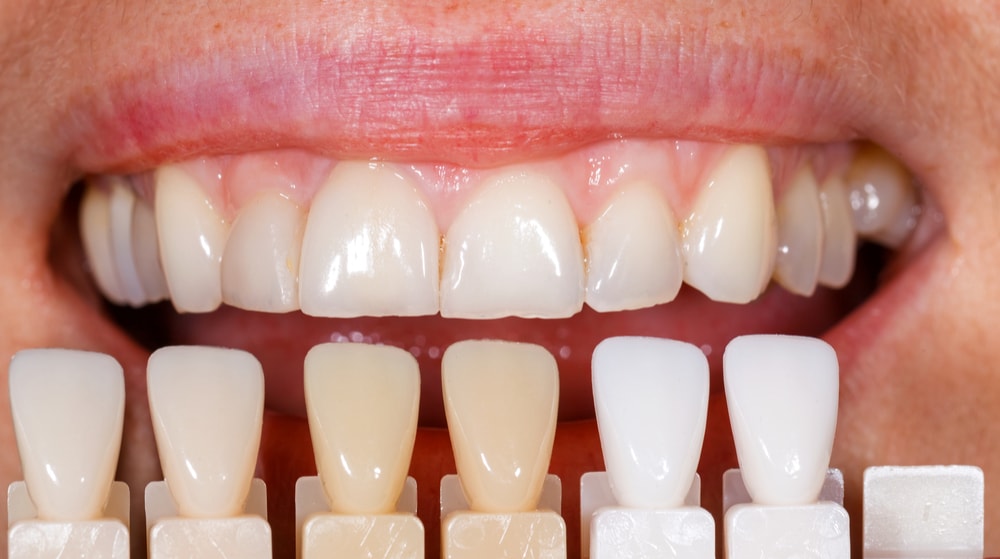
The explanation of why natural tooth color is darker than pure white is simple.
Teeth consist of an outer enamel layer and an underlying dentin layer. Enamel is less transparent and darker than dentin and shows through the enamel layer giving it a light gray or (light) yellow color. Hence, larger teeth like molars or canines are darker than other teeth. Dentin’s larger bulk shows through the enamel.
Likewise, females’ teeth are somewhat whiter than those of males because their teeth are smaller and hence have less dentin.
So, the obvious question is how white your teeth can get with the different teeth whitening methods available (?)
Let’s continue reading.
How white will my teeth get after in-office teeth whitening?
After the 30-60 minutes treatment, your teeth whitening may vary:
- from 10 to 15 shades whiter,
- to 2 to 5 shades lighter.
However, 10-15 shades lighter in color is only seen in a small percentage of patients. Most patients have an average result of 7-8 shades lighter when using Zoom® Whitening.
The average whitening potency of Opalescence® Boost instead, is approximately four shades lighter.
As previously said, your results will be quicker if you choose in-office whitening versus OTC products. And the reason is that higher concentrations of bleaching agents are used in the former.
Let’s now briefly summarize the advantages of in-office teeth whitening.
The benefits of in-office teeth whitening
Here is a brief summary of the main benefits of professional teeth whitening:
- If performed by a professional, results are consistent. This is different from home whitening procedures with OTC products.
- It is one of the safest dental treatments available (since it is supervised by a dentist).
- Sensitivity levels generally remain low, both during and after the procedure.
- Results can be immediate. It only requires a short time (1-1:30 hours). So, it is ideal for busy patients.
- Whitening results are long-lasting.
Now, after an in-office procedure do teeth whitening results vary over the following days?
To answer that, please check the next section.
How will my teeth’ color change shortly after teeth whitening?
Your teeth color may lose some of their light shade the week following the procedure.
Sometimes, part of the color change is due to dehydration. This regresses with time. As your teeth rehydrate, the color rebounds back to a shade darker than the one observed immediately after treatment.
What will my final result be like after in-office teeth whitening?
Your teeth’ color will depend on the types of stains initially present.
Now, different stains present different challenges. For instance, yellowish stains respond better to treatments than brownish stains. But this notwithstanding, it is impossible to predict the exact final result of in-office teeth whitening. Even if all your stains were yellow, it would be futile to try and predict your teeth’ final color.
It is also impossible to tell (in advance) how many shades lighter your teeth will become. The actual outcome depends on:
- your initial level of staining.
- On the mineral composition of your teeth.
The only way to know for certain is by trying an in-office teeth whitening procedure.
You may not know this … but your dentist will always take an initial and final measure of your teeth’ shade. He will use these for comparison purposes.
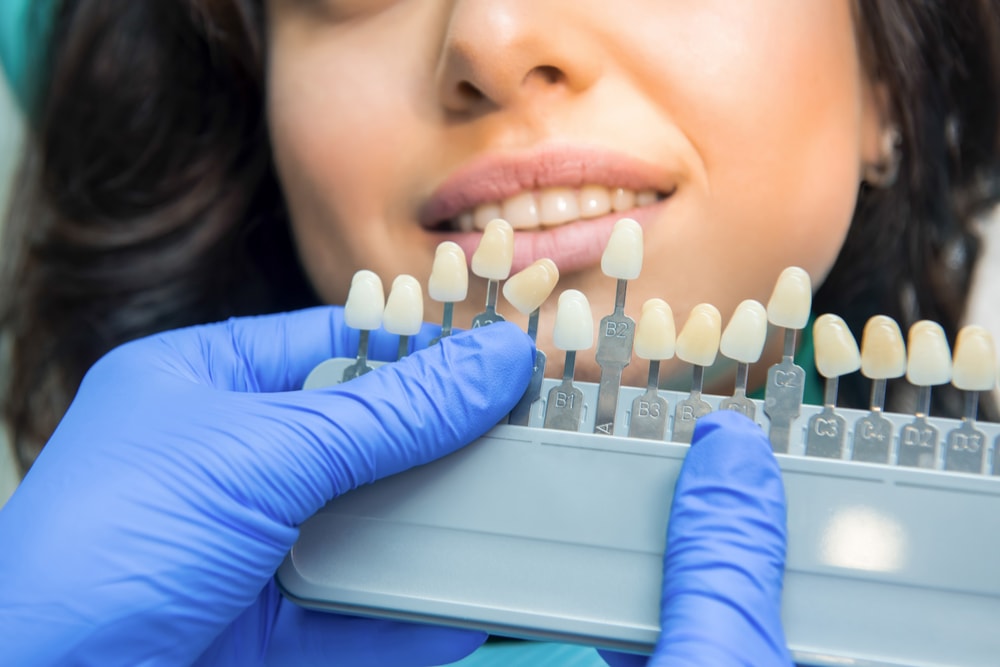
The final natural shade is different for each patient. Now, some patients want their teeth to look natural, as they were before their staining. Although not a guarantee, this is possible.
In-office procedures bring out your natural color by removing deep as well as surface stains. Hence the results will look more natural than with other less robust methods that cannot treat deep stains.
We talked about yellow and brown stains, but what about gray stains?
Can in-office teeth whitening treat grayish stains?
Why do teeth have gray stains (at all)?
A grayish undertone may be due to certain medications taken at a young age. These include:
- tetracycline, to treat a disease;
- minocycline in adolescence or young adulthood to treat acne.
Tetracycline and minocycline staining involve the dentin layer which is underneath the enamel. Prolonged bleaching may thus be required because the gel takes longer to reach this inner layer.
A grayish discoloration does not respond well to tooth whitening. Though grayish stains should improve after treatment, they may persist, at least partially.
Let’s now briefly talk about white spots (on your teeth) that look like stains but are instead decalcifications.
How effective is in-office teeth whitening if you have decalcifications?
These will become more visible (and show as white spots) after the first procedure.
Though, they will become less noticeable after a few treatments.
Another question that may have been on your mind is ….
Does the use of high-intensity light improve in-office teeth whitening?
Some believe it improves the quality of the bleaching process. Studies, though, tell a different story (see also https://www.suttonpda.com/in-office-teeth-whitening/#laser-light). No study has shown an advantage in whitening procedures using these lights.
One 2012 article indicates that their usage:
- “increases the risk of tooth sensitivity during in-office bleaching”;
- “may not improve the bleaching effect for high concentrations of hydrogen peroxide (25–35%)”.
So, the article encourages dentists to avoid or to be cautious when using this type of light activation.
Finally, some more recent articles report that the use of in-office high-intensity light:
- did not increase efficacy nor speed-up in-office bleaching; “The in-office bleaching treatment of vital teeth did not show improvement with the use of light activator sources for the purpose of accelerating the process of the bleaching gel and achieving better results.”
- tended to increase the temperature of the dental pulp.
Hence, the ADA does not endorse these whitening procedures.
Let’s now answer an important question you may have.
Can teeth be re-whitened?
Yes, it is possible.
Your dentist can re-whiten your teeth in the dental office. But you can also do it at home if you have custom-made bleaching trays and whitening gels.
You will be able to whiten your teeth as often as you need to.
Talk to your dentist to find out how often you should repeat your whitening procedure.
You can then determine which whitening products would work best for you.
Base your decision on your individual needs and lifestyle.
Let’s now look at results obtained with other teeth whitening strategies.
Do whitening washes, strips, gels on trays, and paint-on films for home use, whiten teeth effectively?

Before we answer the question, a brief reminder … You can get these whitening products from a dentist or use OTC.
Now, on to the question.
These products work proportionally to the concentrations of the bleaching agents (hydrogen peroxide or carbamide peroxide) present. And based on all we previously said, it is probably not a surprise for you.
The good news is that there is evidence they are better than no treatment at all or a placebo. Though, most of the studies were short-term and financed or run by the manufacturers. Hence, the likelihood of bias remains high.
Also, there is a general lack of data to assess their long-term effects, on diverse populations.
As a general rule, one can say can they lighten your teeth by 1 or 2 shades, after several days of use.
For instance, paint-on whitening gels can lighten your teeth by 1 or 2 shades.
Likewise, whitening washes usually take 3 months to lead to 1 or 2 shade improvements in tooth color.
The same is true for tray-based methods. You can observe an effect of 1-2 shades within a few days. Though, you must follow manufacturers’ instructions.
What about whitening toothpaste?
They are not the open sesame to a glittering smile. Their effect on the tooth color is also in the order of one or two shades. Although, whitening toothpastes are better than standard toothpastes because they can remove or prevent surface stains.
And, last but not least, is charcoal toothpaste good at the job of stains removal?
Unfortunately, despite being touted as effective whiteners, there is no data to back up these assertions. A 2017 review article in the Journal of the ADA concluded saying that:
- There is a lack of data to draw any conclusions about the safety and efficacy of this type of toothpaste.
- Dentists “should advise their patients to be cautious when using charcoal and charcoal-based dentifrices with unproven claims of efficacy and safety.”
To ensure you choose a safe and effective dental product, select those that have the ADA seal of acceptance. As explained before (see Which are the best whitening strips?) for a product to qualify for the seal, the manufacturer must submit safety and efficacy data to the ADA.
Let’s now investigate how you can continue enjoying a bright smile after teeth whitening.
Maintaining teeth whitening results
How can I enjoy prolonged results after Zoom® teeth whitening or Opalescence® Boost?
Custom-fitted touch-up trays or take-home bleaching kits are the solutions. Your dentist can provide them along with instructions for optimal use. Following the instructions should prolong the whitening effect of your initial treatment (Zoom teeth whitening or Opalescence Boost).
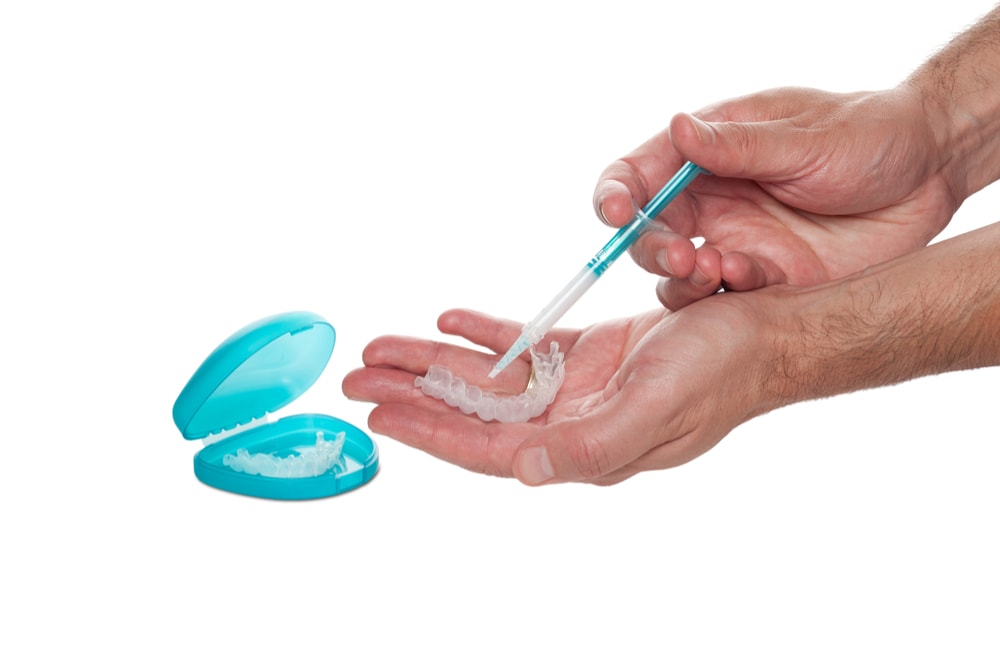
Although there is not an absolute rule, the general advice is to use them for:
- about 1 hour a day for a period of 7 to 10 days;
- then 1-2 days every 6-12 months to maintain a lighter shade.
Each patient is undoubtedly unique. While some may not need them at all, others may need longer treatment periods.
You should not conclude from the above that, as long as you continue using trays with gel, prolonged results are forever. That is very unlikely to happen since your lifestyle plays a major role.
Read on to find out.
How long do in-office whitening results last?
Teeth whitening is not a permanent solution. You need to repeat it periodically, to maintain the whiteness of your teeth. Stains will come back gradually over time and this also depends on your lifestyle, for example :
- if you are a smoker,
- if you consume large amounts of staining foods or drinks such as coffee, red wine, tea, etc…
You may see the whiteness begin to fade in as little time as 4 to 6 weeks.
If instead, you avoid or dramatically reduce these sources of staining, you may not need another whitening treatment for at least 6 to 12 months.
Some good habits to maintain your teeth-whitening results
As explained above, teeth-whitening results are not like diamonds, they are not forever. But you can still make yourself less susceptible to further staining.
How?
The best way to maintain your teeth’s natural color is through:
- following proper dental hygiene regimens such as:
- brushing your teeth two to three times a day
- flossing once a day to remove plaque
- brushing immediately after meals
- rinsing your mouth with water after meals
- using daily antibacterial mouthwashes to kill plaque bacteria.
- Avoiding consumption of beverages that easily stain teeth such as:
- dark colas
- red wine
- coffee
- Using a straw to avoid direct contact between these drinks and your front-facing teeth.
- Brushing or rinsing quickly after consumption of these foods and beverages.
- Using a whitening toothpaste occasionally (4-6 times a month) to prevent staining.
- Doing touch-up treatments by wearing custom-fitted trays or disposable trays.
- A few hours for a couple of weeks should be enough.
- Their frequency will depend on the method used, and on your lifestyle. The need for touch-up treatments may vary from once every six months to once every 1-2 years.
Let’s now briefly discuss whitening results in the presence of dental restorations (crowns, veneers, implants …).
Teeth whitening and crowns, veneers, implants, fillings, and bridges
Teeth whitening’s impact on the color of crowns, veneers, implants, bridges or fillings.
Have you thought about the effect of teeth bleaching on preexisting dental work?
If not, then you should.
Fortunately, teeth whitening has a very limited impact on the color of materials used in fabricating crowns, bridges, and implants.

Ceramics or composite materials (composite resins) as well as gold alloy, do not change color (unless you polish them).
Why?
Because they are very hard materials that can withstand the bleaching procedure.
But unfortunately, teeth whitening’s impact on the structure of crowns, veneers, implants, bridges, or fillings may not be negligible. Bleaching agents may cause structural changes in your restorative materials.
Surface changes, like the weakening of certain materials, can occur. These structural changes may also speed up their wearing down after frequent brushings. Hence, you may end up having to replace your dental restorations.
Among materials that are significantly altered you will find:
- Amalgams,
- glass–ionomer cements,
- and compomers,
which are used to treat cavities.
For instance, the solubility of glass-ionomers and other types of cement has been reported to increase.
But that is not all.
Prolonged treatment with bleaching agents also increases the release of mercury from amalgams. It seems that this is due to microscopic changes in the amalgams’ surfaces. The effect of bleaching on these materials depends on the time of application and peroxide concentration. Thus, your dentist should complete teeth whitening treatment in the shortest possible time.
Given the above, it is not surprising that the ADA and the SCCP advise using lower concentrations of bleaching agents.
You may also be interested to know that …
Many laboratory studies have shown how teeth whitening may affect the bond strength between:
- The materials (crowns, implants, fillings, ..)
- and your enamel or dentin.
For instance, teeth whitening affects the bond strength between enamel and resin-based fillings.
So, if you have dental restorations, check with your dentist before bleaching your teeth.
Teeth whitening before or after veneers, bridges, crowns, implants, or fillings?
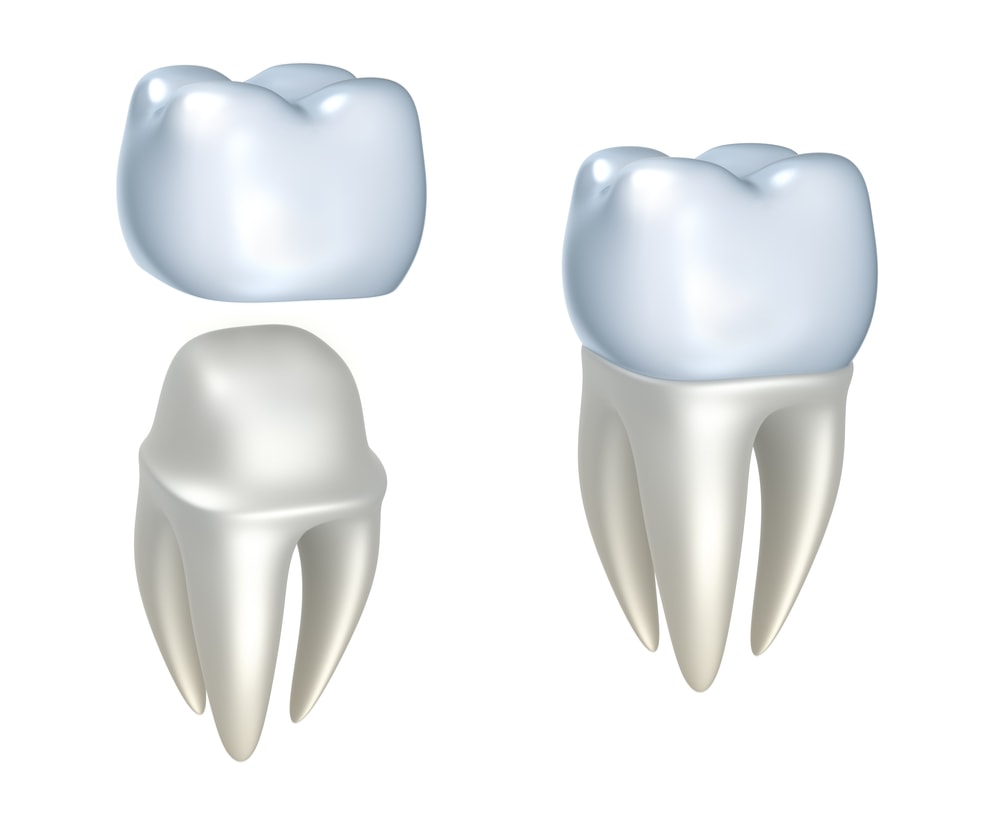
As we have seen above, restorations do not whiten during a bleaching procedure. Let’s see how this may affect your teeth whitening plan.
First and foremost, it is always better to bleach your teeth before any restorations (veneers, crowns, implants, …).
Why?
Because it will help you best match the color of the new restorations to that of your whitened teeth. This is especially true for your anterior (visible) teeth.
Not following this common-sense approach will make your whitened teeth look lighter than your restorations. Hence, you will have an uneven whitening.
But what about if you already have restorations on your front-facing teeth and you decide to undergo a teeth-whitening procedure?
In this case, your dentist can do two things;
- lighten your restorations by polishing them with a non-abrasive cleaning solution.
- (The more involved solution) replace your dental restorations if the discoloration is important and if polishing does not yield the desired result. The goal is to match the new whiter shade of your teeth.
Additionally, if you have several dental restorations (and not just one), you should consider alternative solutions.
These include veneers, crowns, bondings, instead of a whitening procedure.
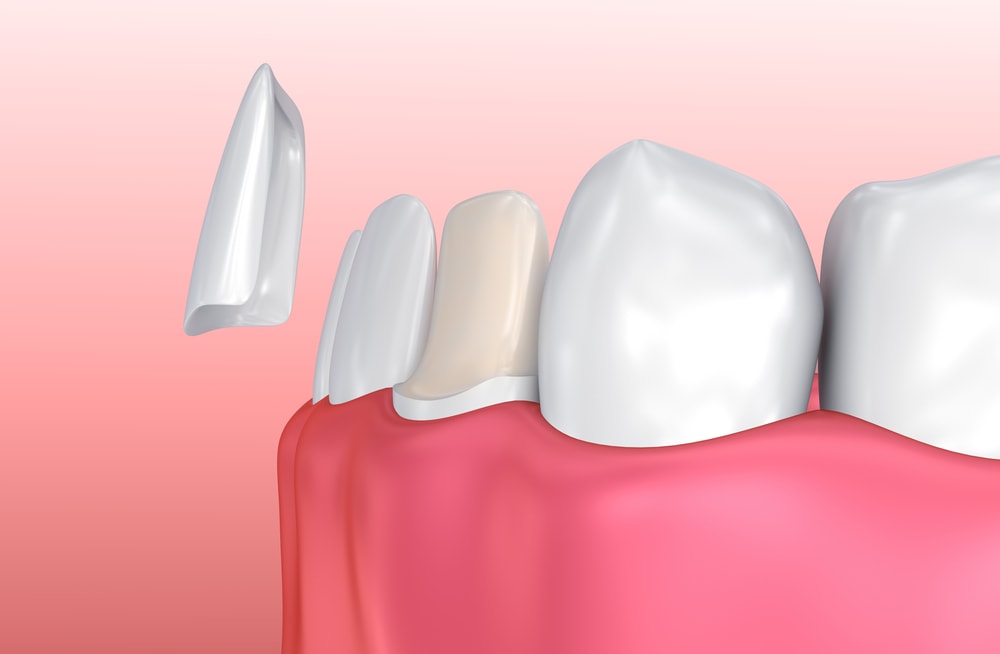
In the next section, we will take a closer look at foods and drinks that can take a toll on your smile.
Food, drinks, and teeth whitening results
What should I avoid eating or drinking after teeth whitening? (Post-care recommendations)
The question may be evocative of a long period of eating restrictions. But that is not true, be reassured. Restrictions apply only for 48 hours.
Why?
Because during this time it is easier for substances to penetrate the enamel. Teeth are dehydrated and enamel’s microscopic pores are open during the first 24 to 48 hours. This phenomenon results from the removal of the dental pellicle.
So, what should one avoid consuming?
The answer is quite simple: anything that could stain a white tee-shirt. It is the best way to preserve the optimal results of the whitening procedure.
More specifically, you should avoid the following:
- Dark staining drinks such as:
- Coffee,
- tea,
- colored alcoholic beverages,
- colored fruit juices,
- colored colas,
- red wine, etc.
- Potato chips.
- All tobacco products. Smoking a cigarette during the first 24 hours will leave a stain on your teeth (see How do teeth get stained from colored food and tobacco?). You can make moderate use of electronic cigarettes.
- You should avoid all fruits especially berries, but you can eat bananas.
- Colored lipstick.
- All dark staining sauces including:
- Soy sauce,
- Bolognese sauce,
- red sauces,
- ketchup,
- mustard, etc.
- red meat,
- chocolate,
- lettuce and tomatoes.
During the first 48 hours (after teeth whitening) you should also avoid:
- Red or blue toothpaste,
- colored gels,
- colored mouthwashes or fluoride treatments,
- periodontal treatments,
- Chlorhexidine, if you are using it to prevent dental plaque.
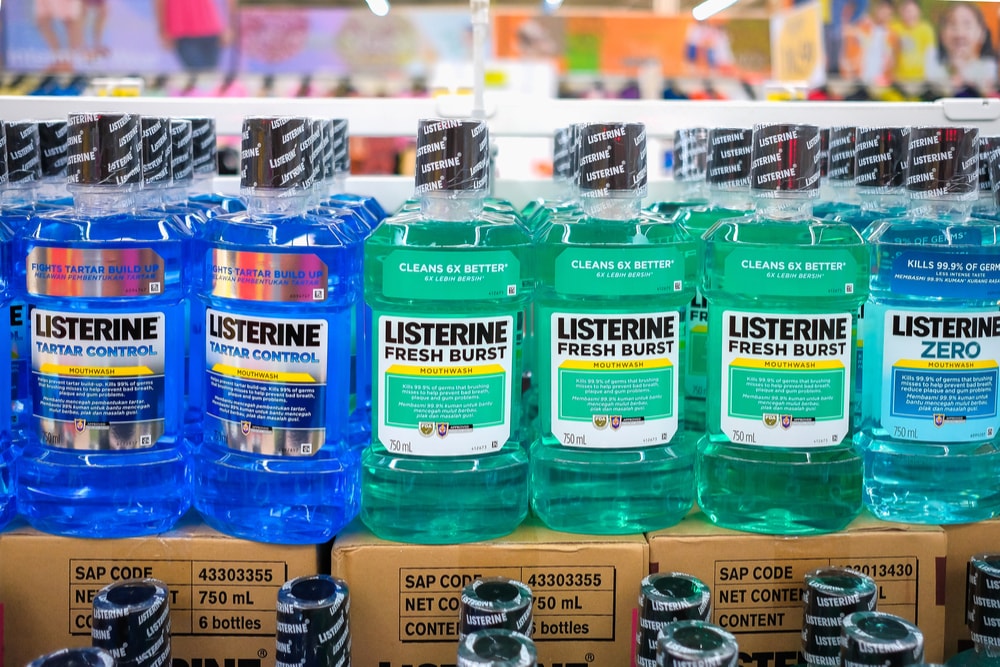
Now that we have seen the don’ts, let’s check the dos.
What can I eat or drink after teeth whitening?
Here are the drinks you can consume during the first 48 hours after teeth whitening:
- milk
- water (still / sparkling)
- white wine
- clear alcohol (Vodka/Gin)
- white lemonade
- clear soda (sprite, 7up)
- club Soda or tonic water
- coconut water but not coconut milk.
As for the foods, here are those you can consume within the first 48 hours after teeth whitening:
- meats:
- chicken breast without the skin or turkey (minus the fat),
- canned chicken breast.
- Fish: white fish, white tuna (without vinegar), fish and chips.
- Carbohydrates:
- white rice,
- peeled potatoes (mashed, baked, or fried),
- plain pasta with white sauces (Alfredo sauce for instance),
- flour tortillas (white),
- white bread (no crust),
- crackers,
- oatmeal,
- cream of wheat,
- cereals (e.g., Rice Krispies),
- pancakes with white syrup.
- Fruits and vegetables: bananas, cauliflower, apples, white onion, pears (no peels).
- Sauces: white gravy, sour cream, mayonnaise.
- Egg whites.
- Desserts: vanilla puddings
- Dairy products:
- White plain or vanilla low-fat yogurt,
- white cheese (mozzarella, white cheddar, cottage cheese).
How to protect your teeth after teeth whitening
If a staining substance has come into contact with your teeth within 48 hours (after the procedure), then you need to take immediate action! Rinse with water and brush your teeth as soon as possible.
Drinking water, as well as chewing sugarless gums, will dilute and decrease your saliva’s acidity.
If you really you can’t do without a coffee or a dark cola after teeth whitening, then use a straw.
Why?
Because it will limit contact to the back of your teeth.
You may also eat cheese because it will coat your teeth with natural wax, covering its pores.
Final remarks
We hope you have enjoyed reading this article.
Please also consider checking the other chapters in this guide:
Chapter 5: natural methods to preserve or whiten your teeth
Teeth Whitening: The Definitive Guide.
Chapter 1: In-office teeth whitening
Chapter 2: Whitening strips, toothpaste, paint-on films, and trays with gels
Chapter 4: Sensitivity and gums’ irritation after teeth whitening
SUTTON PLACE DENTAL ASSOCIATES ON THE WEB






